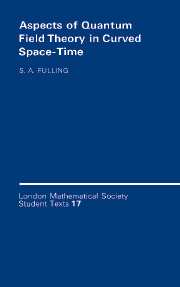Book contents
- Frontmatter
- Contents
- Preface
- 1 A quick course in quantum mechanics
- 2 Self-adjoint, elliptic differential operators and eigenfunction expansions
- 3 Quantization of a static, scalar field theory
- 4 Two-point functions
- 5 The stress tensor and the Casimir effect
- 6 Quantum field theory in general space-times
- 7 Quantum field theory in an expanding universe
- 8 Some geometrical apparatus
- 9 Renormalization of the stress tensor
- Conclusion
- Appendix: Varieties of Instability of a Boson Field in an External Potential and Black Hole Klein Paradoxes
- Bibliography
- Index
Appendix: Varieties of Instability of a Boson Field in an External Potential and Black Hole Klein Paradoxes
Published online by Cambridge University Press: 05 June 2012
- Frontmatter
- Contents
- Preface
- 1 A quick course in quantum mechanics
- 2 Self-adjoint, elliptic differential operators and eigenfunction expansions
- 3 Quantization of a static, scalar field theory
- 4 Two-point functions
- 5 The stress tensor and the Casimir effect
- 6 Quantum field theory in general space-times
- 7 Quantum field theory in an expanding universe
- 8 Some geometrical apparatus
- 9 Renormalization of the stress tensor
- Conclusion
- Appendix: Varieties of Instability of a Boson Field in an External Potential and Black Hole Klein Paradoxes
- Bibliography
- Index
Summary
This document was originally distributed in 1975 by the Mathematics Department of King's College, University of London, as a technical report. (The research was supported by the Science Research Council.) A brief account of its most novel conclusions was published as Fulling 1976.
It is reproduced here verbatim, except for certain improvements connected with the revolution in scientific typography, and the updating of references to some journal articles that were not yet in print at that time.
Analogous studies of the Klein effect for fermions have since been conducted by Bilodeau 1977 for the neutrino field and by Manogue 1988 for the massive Dirac field. Ambjorn & Wolfram 1983 investigate the Schiff–Snyder–Weinberg scenario further; they present evidence that the reaction of the quantized field on the electric field suffices to suppress the instabilities.
Recent years have seen considerable attention to the implications of strong-field effects (on fermions, primarily) for realistic nuclear physics. I understand that the experimental evidence is still inconclusive. From this literature I will cite only these reviews: Rafelski et al. 1978; Soffel et al. 1982; Greiner et al. 1985.
Abstract
Part One A relativistic scalar field is quantized in a one-dimensional “box” comprising two broad electrostatic potential wells. As the potential difference increases, the phenomena found by Schiff, Snyder, and Weinberg in such a model occur: merging of mode frequencies and disappearance of the vacuum as a discrete state, followed by appearance of complex frequencies and unboundedness below of the total energy.
- Type
- Chapter
- Information
- Aspects of Quantum Field Theory in Curved Spacetime , pp. 221 - 286Publisher: Cambridge University PressPrint publication year: 1989



